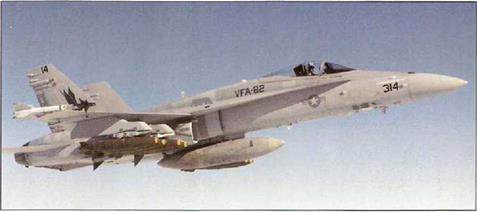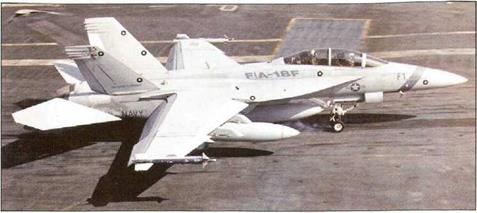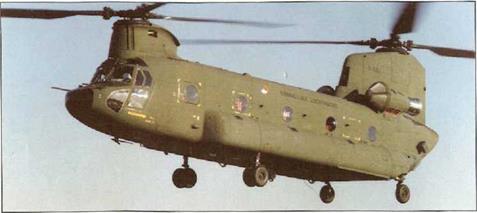Boeing F/A-18A, В, C, D Hornet
|
|
T |
he Hornet was a more sophisticated navalised derivative of the Northrop YF-17, which was developed in its final form in partnership with McDonnell Douglas (now Boeing). The first of 11 pre-production aircraft made the Hornet’s maiden flight on 18 November 1978 and production followed of 371 F/A-18As. A two-seater Hornet version was initially designated TF-18A, before becoming the F/A-18B Basically identical to the F/A-18A, provision of a second seat m tandem was accomplished at a six per cent cut in fuel capacity.
The F/A-18 was revolutionary for introducing a genuinely multi-ro! e capability and the first truly modern fighter cockpit. The pilot has three multifunction displays and true HOTAS controls, which can switch easily from the air-to-ground role to air-to-air or defence suppression duties. The F/A-1 8’s dogfighting capability is remarkable, advanced wing design with large slotted LERXcs conferring excellent nigh-Alpha capability and turn performance Similarly, the multi-mode APG-65 radar is as effective at putting bombs with high accuracy on target as it is at detecting and engaging multiple aifborne targets.
The improved F/A-18C was first flown in September 1986 An expanded weapons capability introduced the AIM-120 AMRAAM, imaging IR AGM-65 missiles end other weapons. The F/A-18C also features an avionics upgrade with new AN/ALR-67 RHAWS, provision for the AN/ALQ-165
airborne self-pro:ection jammer (ASPJ) and improvements to mission computer equipment. After 137 baselfro F/A-18CS had beer delivered, production switched to a night-attack capable version, featuring compatibility with Cat’s Eyes PNVGs, a Hughes AN/AAR-50 TINS (Thermal Imaging Navigation Set) pod, externally-carried AN/AAS-38 targeting FLIP pod and colour MFDs.
The two-seat F/A-18D trainer is broadly similar to the single-seat F/A-18C. However, the US Marine Corps has deveioped a sophisticated two crew combat-capable version, the Night Attack F/A-18D (originally known as the F/A-18D + J. F/A-18D$ can also be fitted with the ATARS reconnaissance system, fitted in a redesigned nose.
F/A-18A/Bs were exported to Australia (57/18 AF-18A/BS), Canada (98/40 CF-188A/Bs) and Spain (60/12). F/A-18C/Ds have been sold to Finland (57/7), Kuwait (32/8) and Switzerland (26/8). The last of 1,479 first-generation Hornets was delivered in late 2000, and production has now moved on to the larger, more advanced F/A-18E/F Super Hornet,
A ‘aggressor’ camouflage scheme marks this Hornet as an aircraft from the Naval Strike and Air Warfare Center, the unit now responsible for ‘Topgun’.
 Specification: Boeing F/A-18C Hornet Powerplant: two 73.73-kN (17.700-lbl General Electric MU’! GE-402 lurbofans Dimensions: wing span 12.Зі n |40 fl 5 in) with :ip-mcunted AAMs, lencth 17.07 m (55 ft): he ght 4.66 m (15 It Sin)
Specification: Boeing F/A-18C Hornet Powerplant: two 73.73-kN (17.700-lbl General Electric MU’! GE-402 lurbofans Dimensions: wing span 12.Зі n |40 fl 5 in) with :ip-mcunted AAMs, lencth 17.07 m (55 ft): he ght 4.66 m (15 It Sin)
Weights: empty ‘CFfab kg (23,050 lb), normal ’.axe-oil 16652 kg (36.710 ib) fighter mission, or 23541 kg (51,900 lb) attack mission Performance: maximum level speed nrore than 191bkmh(1,’OOmph); maximum rate Ы climb at sea level 13715 m (45,000 ftl per minute, combat radius over 740 km (460 miles) Armament: one M61A1 20-mm cannon with 570 rounds, maximum ordnance load 7031 kg (15.5001b)
|
 |
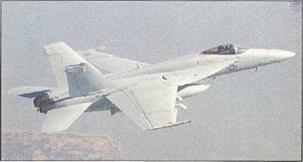 |
When the US Navy was forced to cancel the General Dynamics A-12 long-range, stealthy attack aircraft, :t still faced with the problem of how to replace its A-6 Intruders end early-mode* F/A-18 Hornets. The chosen solution, was to develop an improved version of the Hornet, albeit one that would be suostanrially different to existing aircraft. This Super Hornet was first proposed in 1991 and the engineering and manufacturing development (EMD) contract was officially awarded to McDonnel Doug ss in Jjne 1992. Sir. cle-sear Super Hornets were given the designation F/A-18E, while the two-seat version became the F/A-18F
The Super Hornet is based on the basic F/A-18C airframe, but is longer and heaver with ncreasec wing a^es, larger tai surfaces and extended leading – edge extensions. Many elements, such as the eng ne intakes, have been redesigned to make the aircraft stealthier. The Super Hornet can carry more fuel than earlier Hornets, ard has a mucn higher landing weight limit. The final production standard will be fitted with the AESA radar and a very advanced mission computer fit and digital cockpit.
The Super Hornet EMD contract covered seven prototypes, five F/A-18Es and two F/A-18Fs. The first Super Hornet (an E) made its maiden flight on
The F/A-18E/F has a reprofiled, deeper wing with larger control surfaces than the F/A-18C/D, and a distinctive ‘dogtooth’ on the wing’s leading-edge.
29 November 1995. On H February 1996 the first aircraft arrived at the Naval Air Warfare Centre, Patuxent River, for a three-year test programme. The fifth, and final EMD prototype made its maiden flight or 11 October 1996. Carrier trials began in mid-1996 and low-rate in ifaI production was approved in March 1997 (the same year that Boeing took over tne programme from McDonnell Douglas). By 12 January 1999 the Super Hornet test fleet nac flown 4,000 hours.
Durirg flight tests the F/A-18E/F encountered a number of unexpected problems, and suffered much criticism for poor handling and a lack of performance. With the Joint Strike Fighter facing an uncertain future, the Super Hornet is the only next-generation fighter immediately availaole to the US Navy, and so the rectification of any problems with the aircraft was of tne highest priority.
Ir November 1999 tne F/A-18E/F passed its critics Ooeratioral Evaluation and achieved its initial operating capability in 2000. The first active squadron is VFA-122, which was establ shea at NAS Lem,00re, in January 1999. The JS Navy hopes to acquire /8b Super Hornets. Boeing is now offering a SEAD version of the F/A-18E/F to replace the EA-6B Prowler, dubbed the F/A-18C2W or the ‘Growler’.
 |
At the beginning of the 1980s the US Navy launched its VTXTS requirement, to find a replacement for its TA-4J and T-2C carrier-capable trainers. In November 1981, a modified version of the British Aerospace (now BAE SYSTEMS) Hawk was chosen, ■following a fierce competition. This aircraft was selected by the US Navy as its T45TS (Training System), with McDonnell Douglas {now Boeing) becoming the prime contractor. The principal sub-contractor was British Aerospace, which built the wings, centre and rear fjselaae, fin, tailplane, windscreen, canopy and flying controls. As first proposed there were to be two vanants, a ‘wet’ T-45A fitted ‘or carr’er operations and a ‘dry’ T-45B restricted to lane-based training. Life extension of the T-2 and TA-4J led to a decision to acquire 300 T~45As only (later reduced to 187).
In order to tailor the basic Hawk airframe to meet stringent US Navy requirements ‘or carrier operations, the aircraft has a strengthened twin nosegear, compatible with its ship’s steam catapu ts. The main gear is redesigned, with longer stroke oleos. Fir neight and tailplane span are increased end a single ventral fin is added. The ventral airbrake is replaced by two fuselage side-mounted units. The T-45 has new full-span leading-edge sets and is fitted with an arrester hook, US Navy standard cockpit instrumentation and radios, Martin-Baker Mk 14 NACES ejection seats and a rev;sed fuel system.
The T-45A was given the name Goshawk and work on two prototypes began in February 1986. The first T-45 made its maiden flight on 16 April 1988 and an aircraft made its first carrier landing (aboard the USS John F. Kennedy! on 4 December 1991. The first squadron to be equioped with T-45As was VT-21, part of Training Wing 2, based at NAS Kingsville, Texas. This unit was declared ope’ational in October 1993, Full-rate T-45A production was authorised in 1995.
In 1994 a new advanced ‘glass’ cockpit fit, called ‘Cockpit 21’, was flown in a deve. opment aircraft ‘or the first time. This makes the T-45 more compatible with the curent generation of Navy combat aircraft and it s olanned to be refitted to al earlier aircraft. Beginning in 1997 the new digital cockpit systems were fitted to all new-built і-45s (from the 87th example onwards) and these upgraded aircraft have been designated T-45Cs.
-45Cs can be identified by the GPS antenna fitted to their spines. T-45C de iveries are scheduled to continue until 2005.
 |
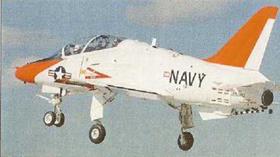 |
The T-45A is based on the Hawk Mk 60, but a number of important changes have been made for its demanding carrier training role,
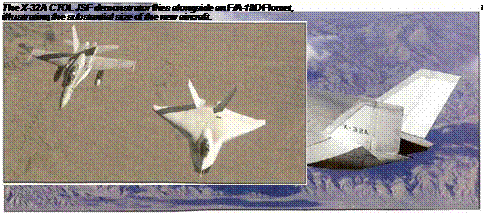
The US Joint Strike Fighter (JSF) programme is an ambitious effort to develop a replacement for an entire generation of USAF, US Navy and US Marine Corps aircraft using one common ‘stealthy’ airframe. The JSF is earmarked to replace the F-16, F/A-18, AV-8B and other types in the US ‘nventory, and will also be exportable to customers world wide. The JSF has its roots in a number of studies for advanced, affordable combat aircraft that were launched in the early 1990s. These were merged into the JAST (Joint Advanced Strike Technology) programme in 1995, which later became JSF.
Three contractors – Boeing, Lockheed Martin and McDonnell Douglas – were selected by the US DoD to submit JSF designs. In November 1996 Boeing and Lockheed Martin were selected to build two demonstrator aircraft, essentially JSF prototypes, to conduct a Concept Demonstration Program At the end of this period one single contractor would be chosen to build its winning JSF design. Boeing’s CDP aircraft was given the designation X-32.
While the JSF concept demands a common airframe, there will be different versions for the throe main US users, and two distinct variants of the basic design. The USAF and the US Navy are looking for a conventional take-off and landing
(CTOL) capability, though Navy aircraft will have io be modified for carrier operations. The Marines need aircraft with short take-off and vertical landing (STOVL) capability to replace the Harrier, so the USMC’s JSF variant will have to have a modified propulsion system for vertical lift. Britain’s Fleet Air Arm (Royal Navy) has also signed up to acquire the STOVL JSF to replace its Sea Harriers.
Boeing has built two different CDP aircraft. The CTOL X-32A and the STOVL X-32B The X-32A made its maiden flight on 18 September 2000, while the X-32B flew for the first time on 29 March 2001. Boeing’s JSF design is far more unconventional than its rival, the Lockheed Martin X-35. and features a one-piece blended wing, with twin all – moving vertical tails and inset rudders. The STOVL version has two directional, vemrai exhaust nozzles. The Х-32’s high wing layout was chosen to aid STOVL performance and the chin-mounted air intake ‘droops’ to allow a greater intake of engine air for STOVL flight and hovering.
 |
A decision date on the winning JSF design has been pushed back several tirr. es, but is now planned before the end of 2001. The first operational aircraft are expected to be the Marines’ STOVL variants in 2008, followed by the CTOL aircraft in 2010.

Hughes’ AH-64A Apache was developed to meet a US Army requirement for an advanced attack helicopter (AAH) suitable for the all-weather day/night anti-armour role. The AH-64 is a two-seat helicopter with armoured structure, advanced crew protection systems, avionics, electro-optics, and weapon-control systems, including the TADS/PNVS (Target Acquisition and Designation System/Pilot’s Wight Vision Sensor). Hughes was bought by McDonnell Douglas in 1984, which became McDonnell Douglas Helicopters 1985. In 1997 McDonnell Douglas was itself taken over by Boeing The YAH-64 prototype first flew on 30 September 1975, The production-standard AH-64A entered US Army Aviation service in April 1986 and the last of 821 AH-64As delivered to the Army was handed over on 30 April 1996. The first export customer for the AH-64A was Israel, in 1990. Subsequent customers included Saudi Arabia, the UAE, Egypt and Greece.
In January 1991 Army AH-64As flew the very first mission of Operation Desert Storm, attacking radar positions inside Iraq The lessons learned from Desert Storm fed directly into a new and substantially improved version of the AH-64, the AH-64D, This aircraft is designed to use the Longbow millimetre – wave radar, which significantly increases the Apache’s ability to detect, classify and identify targets at long ranges. AH-64Ds fitted with the Longbow radar (mounted above the main rotor) are known as
AH-64D Longbow Apaches, and are armed with a new version of the Hellfire anti-tank missile, the AGM-114L (or Longbow Hellfire). This radar-guided weapon can be fired from concealed positions and does away with the need to remain in line-of-sight contact demanded by the standard laser-guided Hellfire missile. The first of six AH-64D prototypes flew on 15 April 1992.
The US Army plans to remanufacture 501 AH-64As as Longbow Apaches, Work on the first batch of 232 aircraft began in 1995 and about 170 aircraft had been delivered by mid-2001. A second batch of 269 AH-64Ds will be delivered between 2002 and 2006. The AH-64D has been ordered by the Netherlands (30), Singapore (9) and the UK (67). The Dutch AH-64Ds will not be fitted with the Longbow radar. The UK’s Apaches are being assembled by Westland, as WAH-64Ds. Egypt and Israel are upgrading some of their existing AH-64As to AH 64D standard. The US Army also plans to replace the TADS/PNVS target sight with the next – generation Arrowhead system.
Greece was the first European customer for the Apache, and took delivery of its first AH-64As in June 1995. A total of 20 are now in service.
![]()
|

United States Heavylift tactical transport helicopter
|
|
T |
he Boeing CH-47 Chinook (originally Boeing Vertol) is the US Army’s standard medium-lift helicopter and utilises Vertol’s proven twin-rotor concept with externally-mounted engines. The first of 350 CH-47As was first flown on 21 September 1961 and the type entered service in August 1962. The subsequent CH-47B (108 built) had uprated engines and increased-diameter rotor blades. The CH-47C introduced greater improvements, including further uprated engines and additional fuel. A total of 270 was built, of which 182 were retrofitted with composite blades and crashworthy fuel systems. CH-47Cs were also sold to Argentina, Australia, Egypt, Greece, Iran, Libya, Morocco. Spain and the UK {RAF designation Chinook HC. Mk 1/1B)
The US Army standardised all its_earlier Chinooks as CH-47Ds, beginning in 1982. The CH-47D is a mix of conversions from all three former variants and some new-build machines. The full programme covers 403 aircraft for Army Aviation, re-engined with T55-L-712 turboshafts (with a greater emergency power reserve and greater battle damage resistance), a new NVG-compatible flight deck and triple cargo hooks. The CH-47D can carry up to 55 troops, or a wide variety of loads up to a maximum of 10341 kg (22,798 lb) externally or 6308 kg
(13,907 lb) internally The CH-47D International
Chinook (Model 414) is an export-optimised variant. US Army re-equipment with the CH-47D is now complete, the variant in service with active – duty. National Guard and Reserve units. Foreign operators include Australia, Greece, Korea, the Netherlands, Spain, Thailand, and the UK (Chinook HC. Mk 2/2A). In Japan Kawasaki has built CH-47Ds under licence as the CH-47J and has also developed the improved FLIR and radar-equipped CH-47JA The latest Boeing-built version of the Chinook is the ‘Super D’ or CH-47SD, fitted with a ‘glass’ EFIS cockpit, radar and enlarged fuel tanks {similar to those of the MH-47E). Customers include Singapore and Taiwan.
The US Army’s 25 MH-47E special operations aircraft are used for covert infil/exfil work. They have a fixed IFR probe, NVG-compatible advanced cockpit displays, jam-resistant communications, a terrain-following and mapping radar and AAQ-16 FLIR. Comprehensive defences include missile-, laser – and radar-warning receivers, jammers and chaff/flare dispensers. MH-47Es are armed with M-134 0.30-in mini-guns. The UK is planning to acquire eight similarly-modified versions (based on the CH-47SD) as the Chinook HC. Mk 3
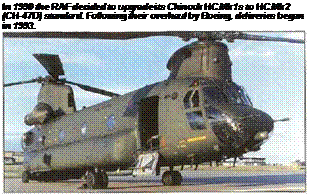 Specification; Boeing CH-47D Chinook Powerplant: two 2237-kW (3,000-tip)
Specification; Boeing CH-47D Chinook Powerplant: two 2237-kW (3,000-tip)
Textron Lycoming T55-L-712 turboshafts Dimensions: rotor diameter, each 18 29 m (SO ft); length, rotors turning 30.14 m (98 ft 1Q/I ml and fuselage 15.54 m [51 ft 0 in); height 5.77 m (18 ft 11 in) to lop of roar rotor head Weights: empty 10151 kg (22,379 lb]; maximum take-off 22579 kg (59.000 lb); maximum payload 10341 kg (22.798 lb) Performance: maximum cruising speed at optimum altitude 256 kmh (159 mph); maximum rate of climb at sea level Б69 m (2.195 ft) per minute; service ceiling 6735 m (22,100 ft); operational radius between 185 and 56 km (115 and 35 miles)











